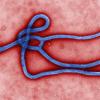Ebola is a rare but serious infectious disease that occurs in Africa and is often accompanied by bleeding in the body. The official name is Ebola virus disease, formerly known as Ebola haemorrhagic fever. It is caused by a virus: the Ebola virus (in the group of filoviruses). Other filoviruses that can cause haemorrhagic fever include the Marburg virus and the Lassa virus.
Ebola is a virus that can make people very ill. This rare disease often leads to bleeding in various parts of the body. So far, outbreaks of the disease have only been found in Africa.
Ebola can only be spread through direct physical contact with a patient, or from slaughtering and eating an animal that has the virus. Once a person has Ebola, there is a significant risk of death. In Africa, more than half of the Ebola patients do not survive. There is no effective treatment for Ebola. Treatment mainly involves fighting complications of the disease. People who are at risk during an outbreak (nurses, doctors, family members of Ebola patients) can be vaccinated. This prevents the continued spread of the virus, slowing the epidemic and hopefully bringing it to an end.
The disease is named after the Ebola river in Congo, where the virus was first found in 1976. In that year, outbreaks occurred in Sudan and former Zaire (currently the Democratic Republic of the Congo). In the years after that, Ebola caused multiple epidemics in various African countries.
Symptoms
Ebola patients can infect other people through direct contact with blood or bodily fluids (faeces, urine, sperm, vomit, saliva or sweat). There are no known cases in which the virus was spread by airborne infection (sneezing or coughing). After infection with the Ebola virus, it takes an average of one week for people to become ill. Patients are contagious once they develop the first symptoms: fever, headache and muscle pain. They may show many other symptoms after that. The most recognisable symptom of the disease is that the virus can cause inflammation in small blood vessels. This leads to internal and external bleeding in various parts of the body. That is when the patient can spread the disease most easily.
Infection and prevention
Bats are the most likely source of filoviruses. These viruses have been found in various bat species that are native to Africa, for example spreading through bat guano. Other animal species living in the tropical rainforests of Africa can also carry the virus, including chimpanzees, gorillas and antelopes. When people kill and eat those animals, they can also get the virus.
In response to an Ebola outbreak, patients are quickly identified and separated (isolated) to prevent new infections. Ebola patients receive care and treatment in a special isolation ward. The people working there follow strict precautions to avoid getting the virus too. People who have had direct contact with a patient are tracked or monitored for some time to see if they become ill. If they also develop Ebola, they are immediately admitted to hospital and receive care in an isolation ward. A blood test can show if a person has been infected with Ebola. In Africa, people who have a high risk for exposure to the Ebola virus can now also be vaccinated. This helps to prevent the spread of the virus.
Spread and frequency
Ebola is an extremely rare disease with occasional local outbreaks in Africa. Infection only occurs after direct contact with people or animals infected with the Ebola virus.



